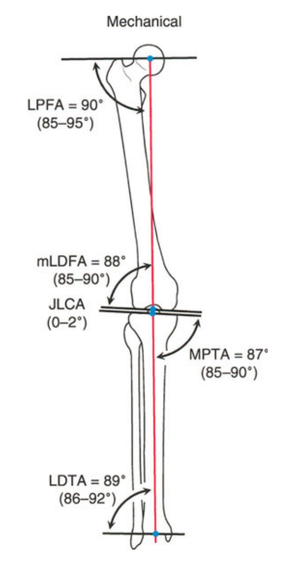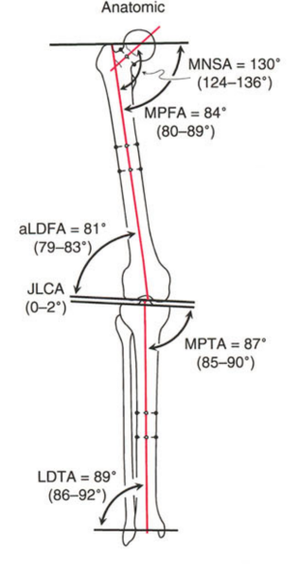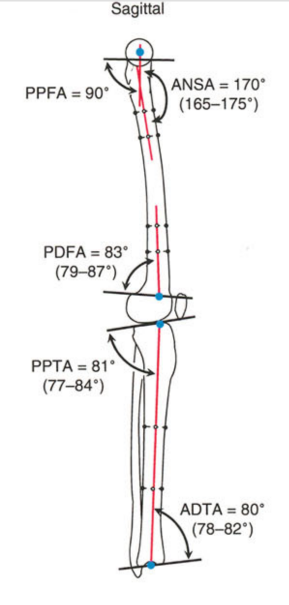The joint lines in the frontal and sagittal planes have a characteristic or well-defined orientation to the mechanical and anatomic axes. This is defined as Joint Orientation Angles.
The name of each angle specifies whether it is measured relative to a mechanical (m) or an anatomic (a) axis. The angle may be measured medial (M), lateral (L), anterior (A), or posterior (P) to the axis line. The angle may refer to the proximal (P) or distal (D) joint orientation angle of a bone (femur [F] or tibia [T]).
The schematic drawings of the nomenclature of the mechanical and anatomical frontal and sagittal joint angles and their normal ranges are described in the below figures (Fig. 5a, 5b and 5c)
Video Summary[edit | edit source]
Mechanical joint angles[edit | edit source]

The mechanical lateral distal femoral angle (mLDFA) is the lateral angle formed between the mechanical axis line of the femur and the knee joint line of the femur in the frontal plane.
The lateral proximal femoral angle (LPFA) is the lateral angle formed between the mechanical axis line of the femur and the proximal joint line of the femur in the frontal plane
The medial proximal tibial angle (MPTA) is the medial angle formed between the mechanical axis or anatomic axis line of the tibia and the knee joint line of the tibia in the frontal plane.
The lateral distal tibial angle (LDTA) is the lateral angle formed between the mechanical axis or anatomic axis line of the tibia and the distal joint line of the tibia in the frontal plane.
The joint line convergence angle (JLCA) is the angle formed between the femoral distal joint line and tibial proximal joint line in the frontal plane
Anatomical frontal angles[edit | edit source]

The anatomic lateral distal femoral angle (aLDFA) is the lateral angle formed between the anatomical axis line of the femur and the knee joint line of the femur in the frontal plane.
The medial proximal femoral angle (MPFA) is the medial angle formed between the anatomical axis line of the femur and the proximal joint line of the femur in the frontal plane.
The medial neck shaft angle (MNSA) is the medial angle formed between the anatomical axis line of the proximal femur and the neck axis of the femur in the frontal plane.
Anatomical sagittal angles[edit | edit source]

The posterior distal femoral angle (PDFA) is the posterior angle formed between the anatomical axis line of the distal femur and the distal joint line of the femur in the sagittal plane.
The posterior proximal tibial angle (PPTA) is the posterior angle between the anatomic axis of the tibia and the proximal joint line of the tibia in the sagittal plane
The anterior distal tibial angle (ADTA) is the anterior angle between the anatomic axis of the tibia and the distal joint line of the tibia in the sagittal plane.
